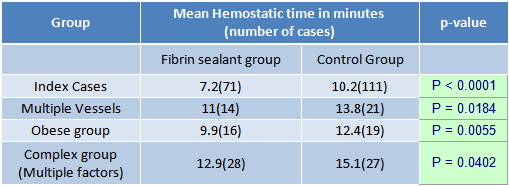Back
Introduction: Intraoperative bleeding is one of the major complications associated with vascular anastomosis in kidney transplant. One of the novel measures for its prevention is the application of fibrin sealant over renal vein anastomotic site after completing the suturing. Till date, there is no study published to evaluate its role for this purpose. Hence, the current study was undertaken to evaluate the hemostatic role of fibrin sealant on renal vein anastomosis during renal transplant surgery.
Methods: This was a prospective randomised study (FORVEIN stands for Fibrin sealant On Renal VEIN anastomosis) done in our institute from April 2017 to March 2022. Approval of the study protocol was obtained from the Institutional review board. Total 307 renal allograft recipients (with age 18 to 60 years) who had undergone live related renal transplant at our center were included in the study as per the inclusion and exclusion criteria. Patients were randomised according to computer generated random numbers into test group in whom fibrin sealant was to be used and control group in whom saline was to be applied. Time to hemostasis was measured from removal of venous clamps to complete hemostasis at the site and was compared between both the groups. Data regarding age, sex, body mass index, number of vessels was recorded for subgroup analysis. Statistical analysis was done using t-test and MedCalc software (Version 20, Ostend, Belgium).
Results: Out of 307 cases, fibrin sealant was applied in 129 cases, whereas 178 cases received saline application. There was significant difference between mean time to hemostasis in fibrin sealant group (7.2min) and in control group (10.2min) (p < 0.0001). On subgroup analysis, it was found that hemostasis time was significantly lower in fibrin sealant group for multiple vessels, obese and complex cases with multiple factors (P=0.02, P=0.005, P=0.04 respectively). No case of venous thrombosis was observed.
Conclusions: Application of fibrin sealant over renal vein anastomosis during renal transplant surgery is safe and effective for achieving early hemostasis. Larger multi-centric randomised controlled studies would be needed for its generalized extrapolation. SOURCE OF
Funding: None

Moderated Poster Session
Session: MP31: Renal Transplantation & Vascular Surgery I
MP31-07: FORVEIN Trial: Evaluation of the Hemostatic Role of Fibrin Sealant on Renal Vein Anastomosis during Renal Transplant Surgery: A Prospective Randomised Controlled Trial
Saturday, April 29, 2023
9:30 AM – 11:30 AM CST
Location: S401A

Tejas M. Mistry
Sir Ganga Ram Hospital
Poster Presenter(s)
Introduction: Intraoperative bleeding is one of the major complications associated with vascular anastomosis in kidney transplant. One of the novel measures for its prevention is the application of fibrin sealant over renal vein anastomotic site after completing the suturing. Till date, there is no study published to evaluate its role for this purpose. Hence, the current study was undertaken to evaluate the hemostatic role of fibrin sealant on renal vein anastomosis during renal transplant surgery.
Methods: This was a prospective randomised study (FORVEIN stands for Fibrin sealant On Renal VEIN anastomosis) done in our institute from April 2017 to March 2022. Approval of the study protocol was obtained from the Institutional review board. Total 307 renal allograft recipients (with age 18 to 60 years) who had undergone live related renal transplant at our center were included in the study as per the inclusion and exclusion criteria. Patients were randomised according to computer generated random numbers into test group in whom fibrin sealant was to be used and control group in whom saline was to be applied. Time to hemostasis was measured from removal of venous clamps to complete hemostasis at the site and was compared between both the groups. Data regarding age, sex, body mass index, number of vessels was recorded for subgroup analysis. Statistical analysis was done using t-test and MedCalc software (Version 20, Ostend, Belgium).
Results: Out of 307 cases, fibrin sealant was applied in 129 cases, whereas 178 cases received saline application. There was significant difference between mean time to hemostasis in fibrin sealant group (7.2min) and in control group (10.2min) (p < 0.0001). On subgroup analysis, it was found that hemostasis time was significantly lower in fibrin sealant group for multiple vessels, obese and complex cases with multiple factors (P=0.02, P=0.005, P=0.04 respectively). No case of venous thrombosis was observed.
Conclusions: Application of fibrin sealant over renal vein anastomosis during renal transplant surgery is safe and effective for achieving early hemostasis. Larger multi-centric randomised controlled studies would be needed for its generalized extrapolation. SOURCE OF
Funding: None

